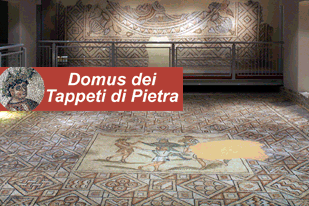Rectory of Santa Maria in Porto in Ravenna






Rectory of Santa Maria in Porto in Ravenna. Hotels near Santa Maria in Porto.
Photo: 1)the Loggia Monastery, known as the Lombardesca ,2)Detail of the cloister and garden, 3)Outside via Roma, Town Art Museum, Zaccagnini Garden, 4)byzantine memorial stone of the Madonne Grecque, 5)Basilica S.Maria in Porto facade, 6)inside of the Basilica
The abbey of the Regular Lateran canons was built in the late I2th century outside the town, where the port, was located at the mouth of the river Badareno, an outlet of the Po river which has today disappeared.
It was for this reason that it was known as Santa Maria in Porto: the "casa di Nostra Donna in sullito adriano" immortalised in the verses of Dante.
It was the Venetian government to invite the monks to move to the town, in order to concentrate their devotional and community work, to prevent the risk of raids by Turkish pirates, as their former seat was too near the sea.
On the construction of the new monastery, within the walls, the monks gave it their name, while the old building became Santa Maria in Porto Fuori. Of this only a few parts remain, following the serious damage suffered during the last war, and the extensive 14th century frescoes the work of the workshop of Pietro da Rimini also disappeared.
In the vicinity of this renovated church, the settlement of Porto Fuori developed. Its transfer to the town, which led to an improvement of the living conditions of the monks, and was also thanks to their close relations with the Lateran monks of Venice. It was in fact their prior, Stefano Morosini, who laid the first stone on 29th July 1494.
The new monastery boasted elegant Venetian architectural styling, in the harmonious elegance of form and proportions that was a features of the loggias on two levels of the cloister and of the main entrance. Another typically Venetian feature, being the extensive use of Istria stone, that was delivered by sea and crafted by Lombard stone cutters, who were active in Venice.
The elegant loggia of the main entrance, being known as the Loggetta Lombardesca. The cloister, terminated in 1502 (the date that is engraved on the pillar), was supported by another, demolished in 1885, that was located on the side of via di Roma where today the Zaccagnini Gardens are to be found.
The building work of the monastery was concluded in 1525 and a few decades after this the monks began the construction of the basilica, the orante façade of which was finalized only in the 18th century. The interior houses the Byzantine memorial stone of the Madonna Greca, which was an object of ancient devotion.
Two organs, were installed for the playing of split choir music during the holy liturgies: it being the only church of Ravenna to be equipped with the same, reflecting its opulence and the fervid cultural climate of the time, in which a series of skilled preachers, tutors and church ministers were trained, many of which became some of the leading exponents of the Counter-reformation movement.
The former monastery today hosts collections of art works of the town museum.
Prof. Gianni Morelli The pleasure of fine accommodation in the centre of Ravenna: we recommend the Fabbri hotels for a pleasant stay as follows:
The Centrale Byron Hotel, 3-star hotel in the centre of Ravenna, close to the main momuments;
The Bisanzio Hotel, 4-star hotel in the centre of Ravenna, close to the main momuments;
Once you have reached the hotel and parked your car, forget it and walk everywhere, because everything is within walking distance.
© reserved copyright





